Between this blog, Facebook, You Tube, and here at the aviaries, I receive tons of comments on an almost daily basis of people claiming, “I want a toucan too!”. Some are obviously just expressing their desire as a figure of speech to share their enthusiasm for the Three-Cans, but some people are definitely more serious than others – people actually considering getting a toucan as a pet sometime in their future, whether it be near or distant.
Because toucans are much more rare of a pet than parrots, fewer people are familiar with the range of species in the toucan (Ramphastos) family. While many may think of my Tocos when they say “toucan”, there are actually over 38 species of toucan, covering a broad range of sizes. To say “I want a toucan” is as vague a statement as saying “I want a parrot”. Parrot can cover anything from a teeny little budgerigar to a giant macaw. The same is true with toucans – the smallest aracaris are less than half the size of the largest toucan species, the Toco.
I wrote a post awhile back titled, “So You Think You Want a Toucan” which describes more of the realities of toucans as pets – challenges that I believe people should take into honest consideration before bringing a toucan into their lives. But because I only have first-hand experience with my three Tocos, the article is mostly centric on challenges associated with keeping the larger toucans as pets. From what I have learned over the past year in the toucan community, the smaller species of toucan such as aracaris and toucanets, are quite different from the larger toucans behaviorally and can make much better pets.
One big aracari fan in particular is Jeff Hunter, who I was fortunate to meet through the Yahoo Toucan Forum and has proceeded to make me fall in love with aracaris with each subsequent conversation we have. He always contributes really interesting information to the forum and has experience with several different species of toucan, both large and small. Jeff’s views on toucans as pets are in alignment with my own and I knew he would do a much better job than I to help weigh the differences between the large vs. small toucans as pets.
You may remember Jeff from one of my past posts in the species special feature series on Curl-Crested aracaris. Without further ado, I’ll give the floor to Jeff, this time to discuss in more depth toucans as pets.
Hi, Jeff. Thank you so much for taking the time to share your toucan wisdom with us. You are definitely one of my favorite people to talk toucans with! You are always so generous with your time and often offer people on the toucan forum a lot of useful advice when it comes to caring for and adopting toucans. You are quite a big aracari fan and often seem to try and steer people away from the larger toucans as pets. Is that intentional?
I’d like to preface my remarks with the admission that these are my opinions, based on my experience and the experiences of close friends who keep (or have kept) pet toucans. As with all generalities, there are going to be exceptions. Also, my remarks on the natural history of Ramphstids are based on the standard published ornithological sources; I have not personally observed toucans or their behavior in the wild.
But I do have an agenda in trying to direct new bird keepers away from the large toucans as house pets. I’ve kept four and still currently have two Tocos. I previously had a Swainson’s and my first toucan was a Plate-billed Mountain toucan. All were hand-raised and tame, but large toucan tame and aracari tame are two different things. The main differences as far as one considering taking a Ramphastid on as a companion animal are two – logistical and cultural.
Okay, let’s start with logistical. What would you say are the main logistical considerations people should make when comparing large vs. small toucans as pets?
I believe that logistically speaking, very few pet owners have the space and place for a large toucan. All of my large toucans were like bulls in a china shop in our house. They need a large amount of space around them to both maneuver and feel comfortable and safe. As you know, a Toco can cover 20 feet in a large hop, barely opening its wings. There aren’t a lot of houses with that amount of open space. And I personally believe that the minimum toucan “cage” should be a large aviary – about the size of yours.
You’re so right. Space is something I am always trying to increase for my big, hyper Tocos. You also mentioned that there are “cultural” reasons that large toucans do not make good pets. What do you mean when you say “cultural”?
The second, cultural reason (and I think one actually can speak of animal cultures) is that the large toucans are more aggressive and singular than aracaris. Aracaris sleep in their tree holes every night, sometimes in fairly large family groups, even when they’re not breeding. Aracari families sometimes communally raise the breeding pair’s chicks. The large toucans generally only use their nest holes during the breeding season. This cultural tendency to feel comfortable with and even crave close physical contact shapes the aracari personality in a way that makes them more suitable as companions for us flightless, biped apes.
Even when in a large flight, aracaris will spend a considerable amount of time sitting next to each other and preening each other. The large toucans do not engage in the behavior as often, and even mated pairs may stay out of actual physical contact with each other for the entire day. As a result, the large toucans crave more personal space and can often take a solicitation intended as affection (an outstretched hand) as a threat action.
Tocos are unique among Ramphastids in a number of ways. According to the literature, they are the only non-forest species, preferring generally open country dotted with trees. And, probably as part and parcel of that (fewer trees = lower concentration of food per acre), they don’t usually travel in the large, often mixed flocks that other toucans do. Swainson’s and Keel-billeds, for example, will travel through the rainforest in very loose flocks of 5 to 7 or more individuals, often mixed with aracaris. So do the mountain toucans and the large uber-family that makes up the Ramphastos vitellinis group (6 to 8 subspecies, depending on who’s counting). Tocos usually travel singly or, at most, in pairs. All the aracaris travel in large family and “tribe” groups (related families), often mixing with other aracari species as well.
Typically, in the animal world, the generalization is usually that the bigger the animal, the calmer its demeanor (ie. small, yippy dogs like Chihuahuas compared to the larger, mellow Mastiffs). I feel like my large Tocos are so high energy and almost spazzy at times. I’ve often thought that the smaller toucans must be even wilder. Have you found that to be true?
It almost seems to me that the smaller size of the aracaris actually makes them less “twitchy” and nervous, because they are comfortable with less personal space around them. I always used to tell visitors that though Daisy, my femaleToco, is the biggest of my toucans, she is also the most “chicken”. She is very afraid of strangers, whereas the aracaris are all over them in a minute, hopping down their shirts or up their pants legs. Again, the Toco is the only non-flocking toucan, which makes them even more independent.
That’s interesting. I’ve heard Toco toucans referred to as the “gentle giants” of the toucan world, similar to the Hyacinth macaws of the parrot world. What do you think about that?
That hasn’t been my experience. There are times when Tocos are gentle – on their terms, and they decide the time, and with which person. My Swainson’s toucan, Jimmy, was gentler than any Toco I’ve interacted with – but even he would choose his times and people. My sister has a Swainson’s who is very bonded and gentle with her, but won’t let any of her friends approach.
Daisy, my female Toco, has personally given me brief experiences of synesthesia – I swear I have tasted colors and touched sounds for about 10 minutes after a good pounding on the skull from her when changing out a food dish. And then she would be sweet as pie 2 minutes later. In Japanese, the Toco toucan is called the “Devil Toucan” by the way(オニオオハシ). So much for gentle giants.
How would you say the larger toucans adjust to the typical human home in comparison to the aracaris?
The greater size, independence, and perhaps intelligence of the larger toucans, in my opinion, makes them a good pet for one household in a million; ideally, they should be kept at liberty, like many are in Central and South America – flying about in the garden or forest as they please, and coming back to the human home to play, eat, or roost as they please. Your situation is a very close second to that – you’re doing it right.
An aracari, on the other hand, can be incorporated into a human household fairly easily. Rocky, my Curl-Crested aracari, follows me around our (admittedly, quite small) house, turning corners from room to room in flight in a way Daisy the Toco or Jimmy the Swainson’s could never do in that restricted area. When Rocky wants some alone time, he goes back to his cage or perches on the edge of a shallow bowl sitting on top our microwave which he has made his poop station in the kitchen/family room. He joins us on the couch WITHOUT having to drive the dogs out of the room first, and jumps down your shirt to be snuggled or squeezes into a space between you and a pillow or you and a dog or person for a group nap. And he craves physical contact in general. This was also true of the Green aracari I had (my first Ramphastid, Frank, now “stolen” by a dear friend who lives nearby and fell in love with him) and is true for a friend’s Collared aracari, Rafi, who I care for sometimes.
I also had another friend with a large toucan who had such a hard time with her toucan mercilessly attacking her husband that she had to send the bird to “summer camp” – the place of a friend who has large outdoor aviaries, until breeding season was over and her toucan calmed down again. And this friend truly made a superhuman effort to accommodate her toucan. In most households, I think the bird would have been gone by now. I had to get rid of my Plate-billed Mountain toucan for the same reason; he would chase my partner around the house with intent to kill and once inscribed a net “Z for Zorro” slash on his cheek. I traded him back to my breeder for Daisy my Toco.
Are there any other considerations people should take when choosing a large vs. small toucan as a pet?
Last thing to say about large toucans vs. aracaris: noise. Though none of them compare with a parrot’s screech, the beautiful, haunting call of a Swainson’s carries for miles, which is why I had to eventually part with my Jimmy. The call of the Toco carries for blocks. And the call of a friend’s Keel-billed can be heard by neighbors. Not so with an aracari – another thing that makes them an easier fit for Life with Humans.
A sample of a Swainson’s call…
~
If you’d like a closer look into the lives of some of my fellow toucan owners who keep a range of species, you may click on the links below to be directed to some of my earlier interviews:
– Jeff’s Curl-Crested Aracari Crew
Special thanks to Jeff for all of his insights. If you’re thinking of adopting a toucan and have further questions, please do not hesitate to contact me at toucanlady@adventuresintoucanland.com and I will be happy to help in any way I can, including putting you in contact with others who may better answer your questions.
*The pictures in this post were provided by Jeff Hunter, Emily Reinys, Anita Tash, and me. *



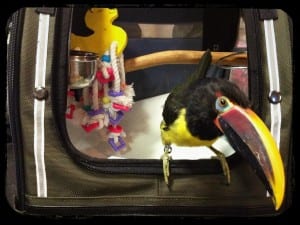
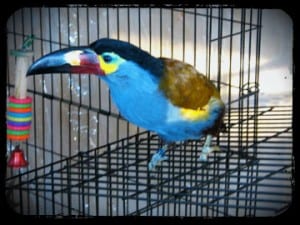
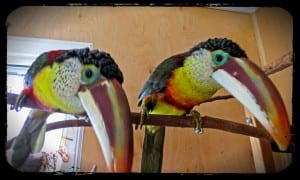
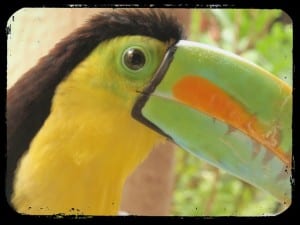

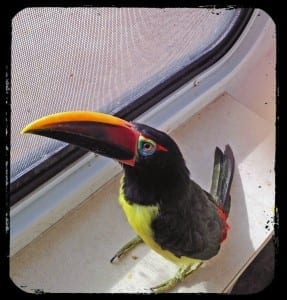



How large is your toucan cage? Does the toucan normally fly or hop? Thank you for your wonderful website, I’ve learned a lot!
Thanks, Jill – glad it’s been helpful to you! It depends on the species/size of toucan. The toucans hop a lot, so need branches to do so. But they also need to fly for exercise and mental health. For our Toco toucans, they each lives in a 10ft x 12ft aviary.
I actually expected them to be much louder than the video shows. Then again I live with a sun conure and a quaker parrot and they love to get into screaming contests. Neither of their breeds are known to be very quiet.
Yup – even the loudest of the toucans are nowhere near as loud as parrots! 😉
Chrissann & the Cans